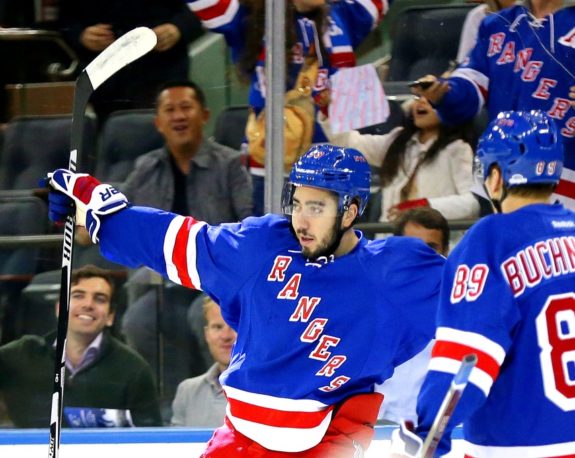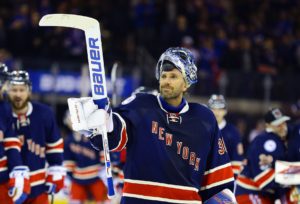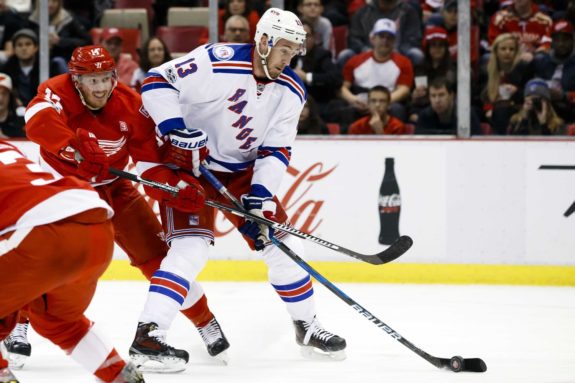In New York, professional sports are scrutinized to no end. It is a boom or bust town where success is only measured by championships. The Rangers have been top contenders for years now, but have failed to win the Stanley Cup, and the second round defeat to the Ottawa Senators last May was yet another playoff misstep.
But, a new NHL season is finally upon us. It’s that time of year when hope is in every locker room. Forgotten are the failings of last season with only blue skies ahead.
The @Senators have led for 35:33 of Game 6 after leading for only 13:10 in the previous five games of the series. #OTTvsNYR #StanleyCup pic.twitter.com/1erwdm5wky
— NHL Public Relations (@PR_NHL) May 10, 2017
For a team to win the Stanley Cup, they need a lot to go right. Consistent and solid play in every aspect of the game needs to happen, as well as catching a few breaks along the way. If the Rangers’ season is a successful one, then here are three paths that led to that success.
Mika Zibanejad Is That Number One Center
In the summer of 2016, the Rangers sent Derick Brassard and a seventh-round pick to the Senators in exchange for Zibanejad and a second-round pick. New York hoped Zibanejad, who was 23 years old at the time, could slot in as a top-six forward.
In Zibanejad’s final season in Ottawa, he tallied 21 goals and 30 assists, good for a career-high 51 points. Unfortunately, his first year with the Rangers did not go as smoothly due to a broken fibula suffered early in the season from an awkward fall into the boards. The injury could be chalked up to bad luck more than anything, but it still stunted his growth as he missed the next two months.
He played in only 56 games in 2016-17 and ended the season with 14 goals and 23 assists. Now, his points per game did increase to 66% compared to 63% during his final season in Ottawa. So, that’s a start. Another positive sign is that he finished the season strong. In the final nine games, he scored three goals to go along with six assists, a point per game clip. He continued to shine in the playoffs with nine points (2 goals, 7 assists) in 12 games, including a game-winning goal in Montreal against the Canadiens.
With the departure of Derek Stepan during the offseason, the Rangers are banking on an improved season from Zibanejad, who signed a new five-year contract to stay in New York. During his tenure, Stepan was the model of consistency. In seven seasons, he accrued more than 50 points in five of them. His rookie season and the strike-shortened year – where he had 44 points in 48 games – were the only two years under that number.
So Zibanejad, who heads into the season as the team’s number one center, needs to play like he’s the number one center. One area where he excelled over Stepan last season was in the face-off department. Stepan’s career-best face-off win percentage was 47%, which he managed last season. Zibanejad, on the other hand, has had three seasons a with a higher success rate.

For three successive years now, Zibanejad has improved his face-off numbers. He finished 35th in the league last season winning 52% of his face-offs in all situations coupled with a 63.5% while on the power play (11th best in the NHL). We will have to wait and see if he will be a consistent scorer in 2017-18, but he will be an upgrade in the face-off circle on that first line.
An Improved Penalty Kill
Over the last two seasons, the Rangers have seen a dip in their penalty kill percentage. For ten consecutive seasons, starting with Henrik Lundqvist’s rookie year in 2005-06 and ending in 2014-15, the Rangers finished with better than an 80% kill rate. Coincidentally, they finished in the top ten in the league nine out of those ten times.

Whether it was Lundqvist’s elite play or players sacrificing their body to block shots, the penalty killing unit got the job done. That all changed in 2015-16 when the Rangers finished with the NHL’s 26th ranked penalty kill. That year, they only managed to kill 78.2% of power plays. Last season they improved, slightly, to finish 19th in the league, killing 79.8% of power plays which is still not good enough.
Lundqvist’s short-handed numbers have dipped a bit in the second half of his career and the Rangers do not block as many shots under Alain Vigneault as they did under John Tortorella, but some sort of progress could be made to improve the penalty kill.
An easy number to look at is face-off wins short-handed. Last season, only the Chicago Blackhawks and San Jose Sharks finished with less face-off wins short-handed than the Rangers and no team finished with a worse percentage. The Rangers only won 38.3% of their face-offs when down a man and 38.8% of their short-handed face-offs in the defensive zone. That is abysmal.
Kevin Hayes was the best Ranger in the face-off department when down a man last season, winning 46.8%. Stepan took the most and only won 37.7%. Surprisingly, Zibanejad won a dismal 31.3% of his face-offs short-handed, down from his 52% win percentage in all situations.

The Rangers did bring in David Desharnais in the offseason to center their fourth line, but he took only one face-off short-handed for the Montreal Canadiens last season. So, he may not be the answer to improve the penalty kill. His 47.8 win percentage in the circle is not ground-breaking, either.
Killing penalties is a vital part of the game. And the Rangers aren’t short-handed all that often to begin with. Last season, they were short-handed for only 223 minutes, which put them in a four-way tie for 23rd. Discipline was not the issue face-offs were. Doing a better job in the circle would subsequently lead to less time defending in their own zone. And the less time defending in their zone should lead to less goals in the back of the net.
Good, Not Great, Goaltending
Lundqvist is aging and his diminishing stats should be a little concerning. At 35, he is coming off his worst regular season. Last year, he posted a 2.78 goals against average (GAA) to go along with a .910 save percentage (Sv%). It was the first time since the 2008-09 season (when he finished with a .916 Sv%) where Lundqvist failed to have over a .920 save percentage.
And as for his goals against, well, that number rose for the second consecutive season. Lundqvist had a goals-against average of 2.25 for the 2014-15 season. The following year, that number rose to a 2.48 GAA which is not awful. But last season’s 2.78 GAA in 57 games is not what the Rangers expect from their starting goaltender.
However, there is a silver lining to this. Despite an inconsistent season from their All-Star goaltender, the Rangers still landed the ninth best record in the league and even with his high goals against average, the team finished with the league’s fifth-best goal differential at plus-36. So, if they can play well with a shaky Lundqvist, then perhaps they can finish even higher in the standings with just a good Lundqvist.

Lundqvist’s play in the playoffs was also a positive. In 12 games against the Montreal Canadiens and Ottawa Senators, Lundqvist looked much better. He overcame a mediocre season and a terrible performance in the 2016 playoffs against the Penguins (4.39 GAA and .867 Sv% in five games) to provide the Rangers with solid numbers, finishing with a 2.25 GAA and a .927 Sv% in the postseason. Knowing the competitor he is, I would not expect his GAA to rise for a third straight year. Expect a rebound performance from “the King.”
One area of concern, though, is backup goaltender Ondrej Pavelec, who the Rangers signed to a one-year deal over the offseason. For his career, he has a 2.87 GAA and .907 Sv%, so it would be naive to think he will be as good as Antti Raanta was last season. Raanta shined in the backup role, en route to a 2.26 GAA and a .922 Sv%. Don’t expect that from Pavelec, who has posted a 2.73 GAA or worse in nine of his ten seasons in the NHL.
This is the most talented team Pavelec has been on in his career and goaltending coach Benoit Allaire is one of the best in the game. He helped turn Cam Talbot and Antti Raanta into NHL starters and will attempt to work his magic with Pavelec as well. The Rangers’ potent offense produced 3.09 goals per game last season, which was fifth best in the league and I expect similar production offensively this season. All this means, that Pavelec will not be expected to stand on his head to get wins when he plays. So, as long as he is serviceable in a limited role, I think he will do just fine.